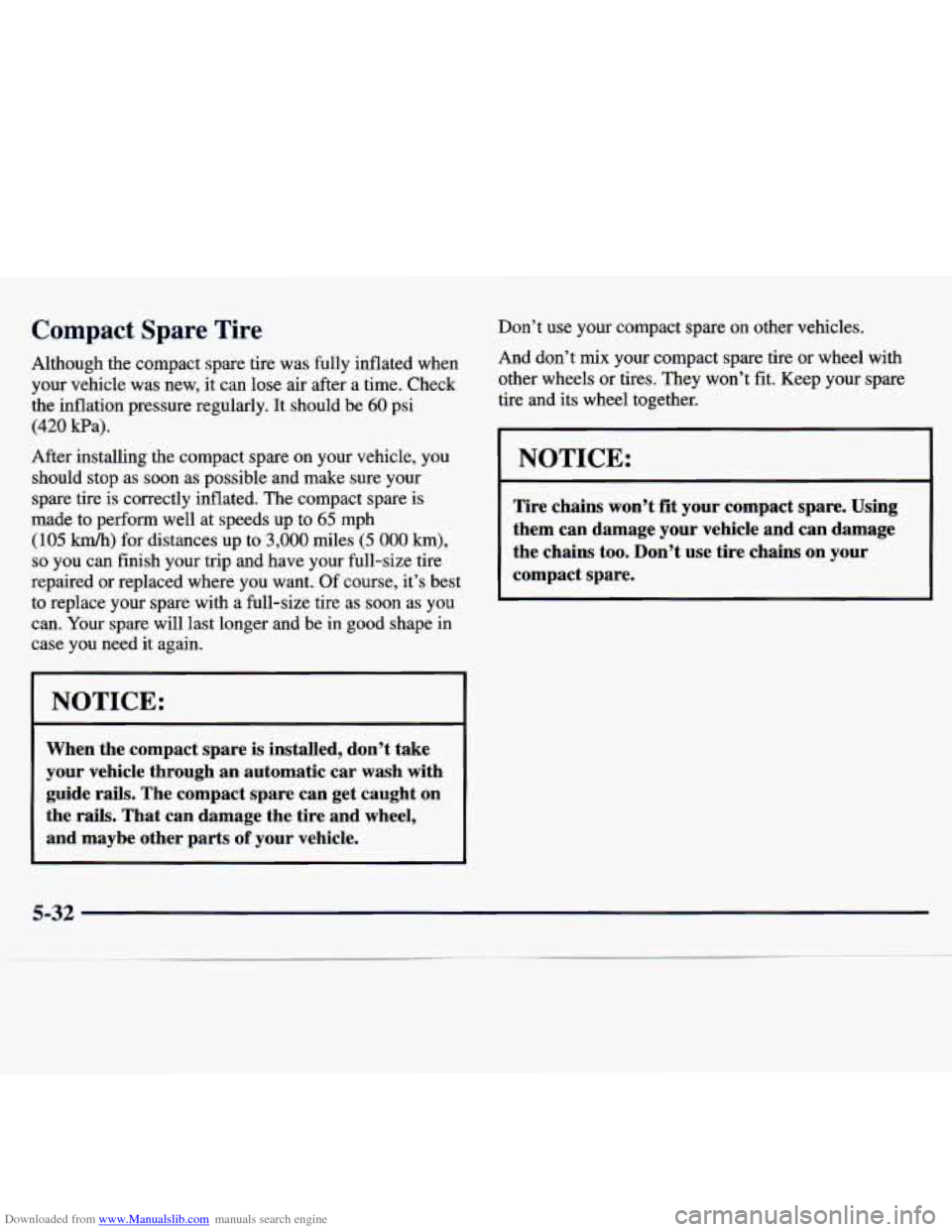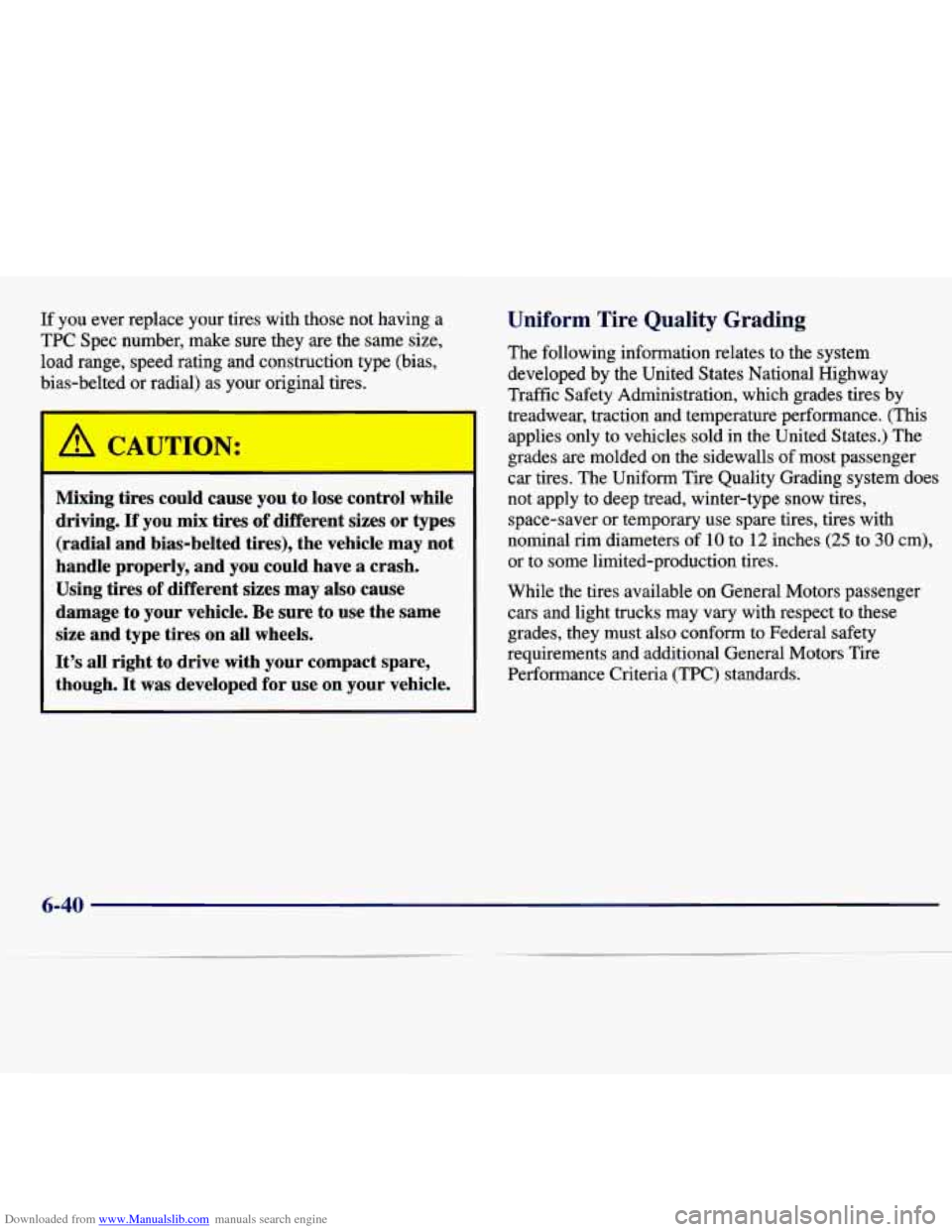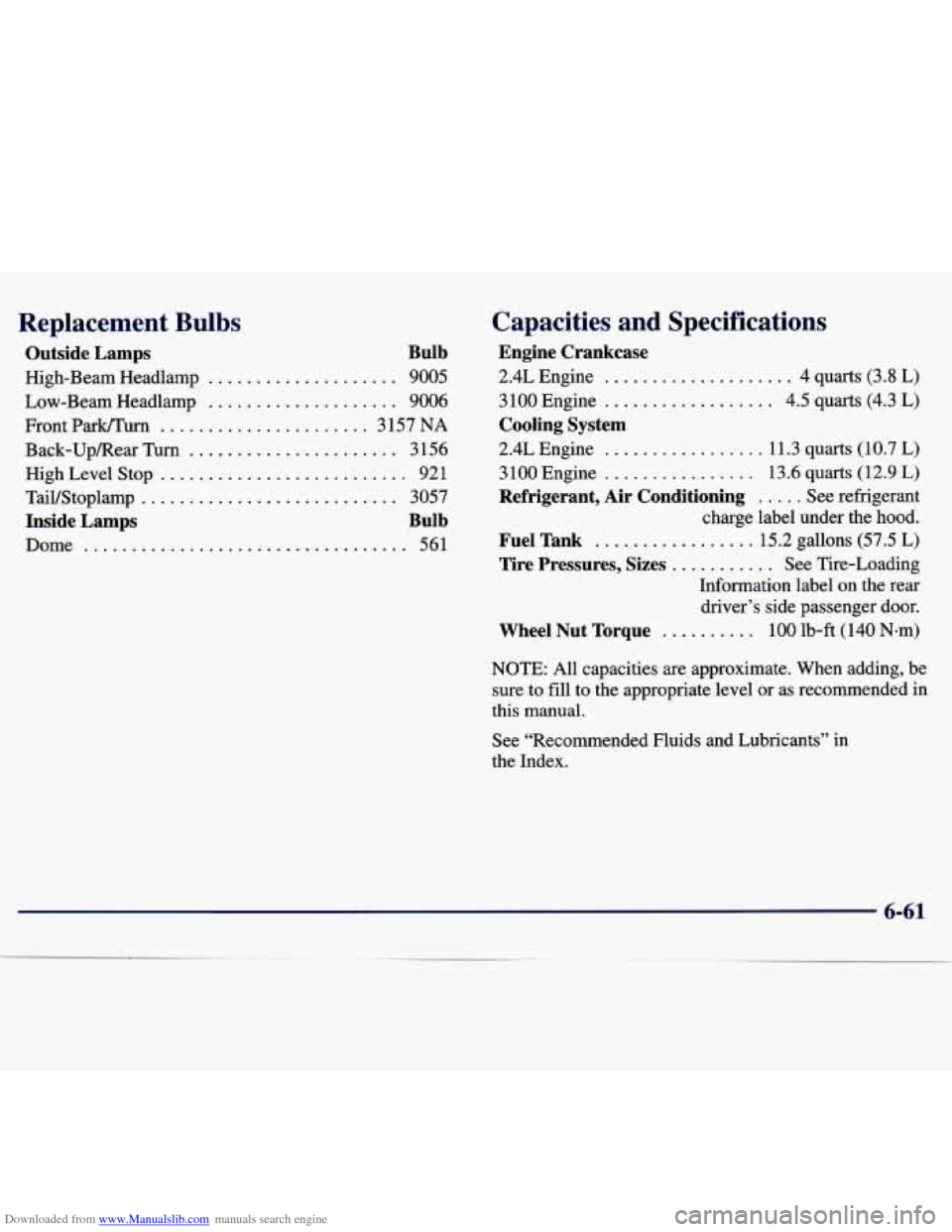Page 218 of 354
Downloaded from www.Manualslib.com manuals search engine Storing the Spare Tire and Tools
equipment in the
passenger compartment
of the vehicle could
cause injury. In a sudden stop or collision, loose equipment could strike someone. Store all these
in the proper place.
__
The compact spare is for temporary use only. Replace
the compact spare tire with a full-size tire as soon as you
can. See “Compact Spare Tire” in the Index. See the
storage instructions label to replace your compact spare
into your trunk properly.
F
G
A. Nut
B. Cover
C. Wing Bolt
D. Adapter
E. Wrench
E Jack
G. Extension (Aluminum Wheels Only)
H. Spare Tire
5-31
Page 219 of 354

Downloaded from www.Manualslib.com manuals search engine Compact Spare Tire
Although the compact spare tire was fully inflated when
your vehicle was new, it can lose air after a time. Check
the inflation pressure regularly. It should be
60 psi
(420 Wa).
After installing the compact spare on your vehicle, you
should stop as soon as possible and make sure your
spare tire
is correctly inflated. The compact spare is
made to perform well at speeds up to
65 mph
(105 km/h) for distances up to 3,000 miles (5 000 km),
so you can finish your trip and have your full-size tire
repaired or replaced where you want. Of course, it’s best
to replace your spare with a full-size tire as soon as you
can. Your spare will last longer and be in good shape in
case you need it again.
NOTICE:
When the compact spare is installed, don’t take
your vehicle through an automatic car wash with
guide rails. The compact spare can get caught on
the rails. That can damage the tire and wheel,
and maybe other parts
of your vehicle. Don’t use your compact spare on other vehicles.
And don’t
mix your compact spare tire or wheel with
other wheels or tires. They won’t fit. Keep your spare
tire and its wheel together.
I NOTICE:
Tire chains won’t fit your compact spare. Using
them can damage your vehicle
and can damage
the chains too. Don’t use tire chains on your
compact spare.
5-32
Page 261 of 354

Downloaded from www.Manualslib.com manuals search engine If you ever replace your tires with those not having a
TPC Spec number, make sure they are the same size,
load range, speed rating and construction type (bias,
bias-belted or radial) as your original tires.
I
Mixing tires could cause you to lose control while
driving.
If you mix tires of different sizes or types
(radial and bias-belted tires), the vehicle may not
handle properly, and you could have
a crash.
Using tires
of different sizes may also cause
damage to your vehicle. Be sure to use the same
size and type tires on all wheels.
It’s all right to drive with your compact spare,
though.
It was developed for use on your vehicle.
Uniform Tire Quality Grading
The following information relates to the system
developed by the United States National Highway
Traffic Safety Administration, which grades tires by
treadwear, traction and temperature performance. (This applies only to vehicles sold in the United States.) The
grades are molded on the sidewalls
of most passenger
car tires. The Uniform Tire Quality Grading system does
not apply to deep tread, winter-type snow tires, space-saver or temporary use spare tires, tires with
nominal rim diameters
of 10 to 12 inches (25 to 30 cm),
or to some limited-production tires.
While the tires available on General Motors passenger cars and light trucks may vary with respect to these
grades, they must also conform to Federal safety
requirements and additional General Motors Tire
Performance Criteria (TPC) standards.
6-40
Page 264 of 354

Downloaded from www.Manualslib.com manuals search engine NOTICE:
The wrong wheel can also cause problems with
bearing life, brake cooling, speedometer or
odometer calibration, headlamp aim, bumper
height, vehicle ground clearance and tire or tire
chain clearance to the body and chassis.
See “Changing a Flat Tire” in the Index for more
information.
Used Replacement Wheels
Putting
a used wheel on your vehicle is
dangerous. You can’t know how it’s been used or
how far it’s been driven. It could fail suddenly
and cause an accident.
If you have to replace a
wheel, use a new
GM original equipment wheel.
Tire Chains
NOTICE:
Use tire chains only where legal and only when
you must. Use only
SAE Class “St’ type chains
that are the proper size for your tires. Install
them on the front tires and tighten them as
tightly as possible with the ends securely
fastened. Drive slowly and follow the chain
manufacturer’s instructions.
If you can hear the
chains contacting your vehicle, stop and retighten
them.
If the contact continues, slow down until it
stops. Driving too fast or spinning the wheels
with chains on
will damage your vehicle.
Page 282 of 354

Downloaded from www.Manualslib.com manuals search engine Replacement Bulbs
Outside Lamps Bulb
High-Beam Headlamp .................... 9005
Low-Beam Headlamp
.................... 9006
Front Park/Turn
...................... 3 157 NA
Back-UpRear Turn ...................... 3 156
High Level Stop
.......................... 921
TaiVStoplamp
........................... 3057
Inside Lamps Bulb
Dome .................................. 561
Capacities and Specifications
Engine Crankcase
2.4L Engine .................... 4 quarts (3.8 L)
3 100 Engine .................. 4.5 quarts (4.3 L)
Cooling System
2.4L Engine ................. 11.3 quarts (10.7 L)
3100 Engine
................ 13.6 quarts (12.9 L)
Refrigerant, Air Conditioning ..... See refrigerant
charge label under the hood.
Fuel Tank ................. 15.2 gallons (57.5 L)
Tire Pressures, Sizes ........... See Tire-Loading
Information label
on the rear
driver’s side passenger door.
Wheel Nut Torque .......... 100 lb-ft (140 N-m)
NOTE: All capacities are approximate. When adding, be
sure to
fill to the appropriate level or as recommended in
this manual.
See “Recommended Fluids and Lubricants” in
the Index.
6-61